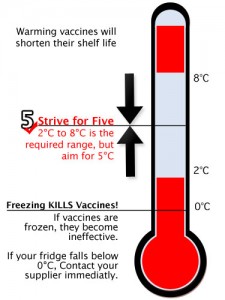
Download & Print the free Fact Poster
This FREE combo poster/fact sheet is the ideal way to train staff and remind them of the importance of correct vaccine temperatures.
There are few situations where temperature control and monitoring is as important as with Vaccines. Vaccines must be stored in the range of 2°C to 8°C (the ‘safe zone’), otherwise they will be damaged or destroyed:
Above 8°C and the vaccines start to perish like any temperature sensitive product, and will experience a greatly reduced shelf life. The higher the temperature the faster the decay. As temperatures approach and exceed room temperature then other changes may occur and some vaccines do perish. If a vaccine freezes, it will die. That is, it will become completely ineffective. If vaccines are stored outside of the 2°C to 8°C range for any period of time, you should immediatly contact the supplier or manufacturer for advice on the quality and usability.
Logging… Confirms the cold chain has been maintained and provides accurate knowledge of the vaccine refrigerator temperature.
National Vaccine Storage Guidelines Australian Government
Why Monitor the Temperature?
No matter what type of fridge you choose, it is wise to make use of a temperature logger to help you ensure the constant maintenance of temperature througout the fridge.
Power failure
If power is lost to the building (ie. black out) or to the fridge only (e.g. it is unplugged by the cleaner) then the fridge is not able to control the temperature. At the same time the built in computer is not able to monitor what is going on. Another device is required.
Fridge failure
If the fridge fails then how do you know what is going on? Independant temperature loggers will keep logging even if everything else fails. Even better still, many models of loggers provide built in alarms to alert you as soon as a problem occurs. It has been recommended by many health authorities and government departments that this independant alarm functionality be utilised in vaccine fridges.
"Policing the police"
The biggest issue, however, is “how do you know if the fridge is actually measuring the correct temperature?” The simplest way is to have an independent temperature monitoring device in the fridge.
Thermocrons are used by the Pharmacy Guild of Australia to audit their members’ vaccine fridges. They were also installed in the majority of GPs when the New Zealand government supplied all GPs with a vaccine fridge.
Ways to monitor Temperature
Most people are familiar with the traditional min/max temperature logger. If a min/max thermometer is used then it should be checked twice a day and the results stored in a log book.
Manual recording, however, is open to a number of issues including staff forgetting to record the readings, or deliberately falsifying results if a problem occurs.
Temperature loggers provide automatic temperature monitoring and record the temperature periodically (every couple of minutes) and can display a graph of the results on a PC. They provide a detailed and reliable account.
If a problem does occur, they also provide invaluable information such as when the problem occurred, for how long, and how warm or cold the vaccines became. This is often the critical information for determining whether to keep or dispose of the vaccines.
In unusual circumstances where vaccines are stored in refrigerators in buildings which
are not accessed daily, data loggers must be installed and they need to be read weekly.Vaccine Cold Chain Guidelines
Western Australian Public and Community Health Services
Causes of Temperature Variations
Lows
Temperatures below 2°C are usually caused by:
- The fridge being set too low (call your supplier)
- The compressor locking on (call your supplier)
- Over stocking the fridge
Highs
Temperatures above 8°C are usually caused by:
- The fridge being set too high (call your supplier)
- The compressor not working (call your supplier)
- The door not being closed properly
- The fridge being opened too often or for too long
- A large amount of warm stock being loaded
- Poor ventilation around the fridge
Know your vaccine refrigerator by recording temperatures throughout the refrigerator… The recording device (data logger / thermometer probe) needs to be left in each position for a minimum of 24 hours.
National Vaccine Storage Guidelines Australian Government
Need Some Advice?
Talk to one of our friendly experts. With over 15 years of experience with temperature logging, our staff know how to provide you with the right solution for your Vaccine Storage temperature logging needs.
[category_horizontal category_id=”1″ columns=”4″ max=”4″ title=”Latest Blog Entries”]